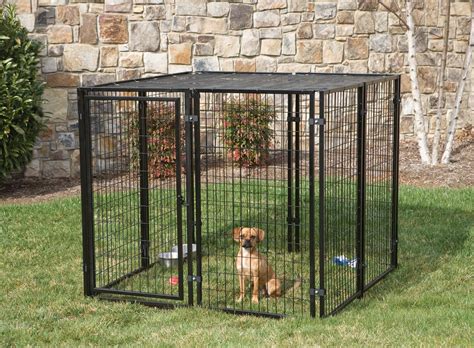Owning a small dog brings immense joy and companionship, but it also comes with the responsibility of ensuring their safety and well-being. A pet fence specifically designed for small dogs can provide a secure and enjoyable space for your furry friend to explore while giving you peace of mind.

Understanding the Challenges of Small Dogs with Traditional Fences
Traditional fences may not be suitable for small dogs due to their ability to slip through gaps or jump over them. Small dogs are also more prone to escape due to their curious and adventurous nature. This can lead to potential dangers such as traffic, lost pets, and encounters with other animals.
Benefits of a Pet Fence for Small Dogs
A pet fence designed specifically for small dogs addresses the unique challenges they face:
- Secure Containment: A fence with a height and gap optimized for small dogs prevents escape and ensures their safety within the designated area.
- Peace of Mind: Knowing that your small dog is safely contained within your yard allows you to relax and enjoy time with your pet without constant worry.
- Improved Exercise: A fenced yard provides ample space for small dogs to exercise and play, promoting their overall health and well-being.
- Enhanced Safety: By keeping small dogs within a fenced area, you minimize their exposure to potential hazards such as traffic, predators, and other animals.
Types of Pet Fences for Small Dogs
Various types of pet fences cater to the specific needs of small dogs:
- Electric Fences: Electric fences establish a perimeter around your yard using a mild electric shock to deter escape. They are effective for both above-ground and underground installations.
- Wireless Fences: Wireless fences utilize radio signals to establish a boundary. Dogs wear a receiver collar that emits a warning tone or shock when they approach the boundary.
- Physical Fences: Physical fences, such as chain-link or wooden fences, provide a tangible barrier. They are typically higher and have smaller gaps than traditional fences.
Choosing the Right Pet Fence for Your Small Dog
Selecting the most appropriate pet fence for your small dog depends on several factors:
- Size of Your Yard: Measure the perimeter of your yard to determine the necessary fence length.
- Breed of Your Dog: Consider the size, jumping ability, and escape tendencies of your specific breed.
- Terrain: The type of terrain in your yard (e.g., flat, sloping, rocky) may influence the installation process.
- Training: Some types of fences, such as electric or wireless fences, require training to ensure effective containment.
Common Problems with Pet Fences for Small Dogs
Encountering challenges with pet fences is not uncommon:
- Escape Attempts: Small dogs may attempt to dig under or jump over fences, especially if the fence is not securely installed or has gaps.
- Battery Issues: Wireless fences rely on battery-operated collars, which need regular charging or replacement.
- False Triggers: Electric fences can occasionally trigger false shocks in small dogs due to their sensitivity.
- Maintenance: Pet fences require ongoing maintenance, such as repairing damaged sections or inspecting wire connections.
Effective Solutions for Common Problems
Addressing common problems with pet fences for small dogs enhances their effectiveness:
- Secure Installation: Ensure that fences are properly buried or anchored to prevent digging or escape.
- Regular Battery Maintenance: Replace or charge batteries in wireless collars as recommended to avoid unexpected shutdowns.
- Proper Training: Dedicate time to train your dog to respect the fence boundary, especially with electric or wireless fences.
- Fence Evaluation: Inspect your fence regularly and repair any damage promptly to maintain its integrity.
Innovative Applications for Pet Fences
Pet fences for small dogs extend beyond basic containment, offering creative solutions for various needs:
- Doggy Daycare: Pet fences can create secure play areas within larger yards, allowing multiple small dogs to socialize and exercise safely.
- Puppy Training: Fenced-in areas provide a controlled environment for puppies to learn basic commands and practice recall without risking escape.
- Garden Protection: Fences can prevent small dogs from damaging delicate plants or digging up flower beds, protecting your garden’s aesthetic appeal.
Frequently Asked Questions
1. How high should a fence be for a small dog?
The optimal fence height for small dogs typically ranges from 3 to 4 feet.
2. What is the average cost of a pet fence for small dogs?
The cost of a pet fence varies depending on the type, size, and installation method. Electric fences tend to be more affordable, while wireless fences offer more flexibility but can be costlier. Installation costs can range from $150 to $500.
3. Can small dogs be trained to stay within a fence?
Yes, with consistent training, small dogs can learn to respect fence boundaries. Positive reinforcement, such as treats or praise, is essential during the training process.
4. Are pet fences safe for small dogs?
Pet fences are generally safe for small dogs when used and maintained correctly. However, it is crucial to choose a fence appropriate for your dog’s size and breed, and to follow proper installation and training guidelines.
5. How do I maintain a pet fence for a small dog?
Regular maintenance is essential for the effectiveness and longevity of pet fences. Check for damage, replace batteries in wireless collars, and clean wires or sensors as recommended.
6. What are some tips for selecting a pet fence for a small dog?
Consider your yard size, dog breed, terrain, and training needs. Measure the perimeter of your yard, research different types of fences, and consult with a professional installer if necessary.
Conclusion
A pet fence for small dogs offers a secure and rewarding solution for responsible pet ownership. By choosing the right fence and implementing effective strategies, you can provide your small dog with a safe and enjoyable outdoor environment while experiencing peace of mind. Remember to address potential challenges proactively and explore innovative applications to maximize the benefits of a pet fence for your beloved furry friend.
